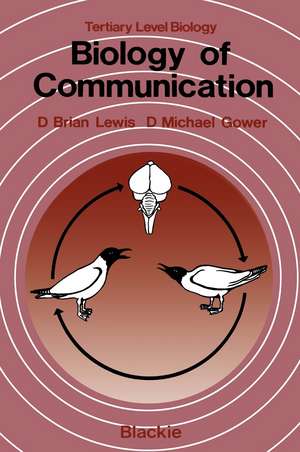Biology of Communication: Tertiary Level Biology
Autor D. Brian. Lewisen Limba Engleză Paperback – dec 1979
Din seria Tertiary Level Biology
- 15%
 Preț: 637.59 lei
Preț: 637.59 lei -
 Preț: 381.00 lei
Preț: 381.00 lei -
 Preț: 382.95 lei
Preț: 382.95 lei -
 Preț: 379.86 lei
Preț: 379.86 lei -
 Preț: 381.59 lei
Preț: 381.59 lei -
 Preț: 387.20 lei
Preț: 387.20 lei -
 Preț: 386.99 lei
Preț: 386.99 lei -
 Preț: 382.18 lei
Preț: 382.18 lei - 15%
 Preț: 633.02 lei
Preț: 633.02 lei -
 Preț: 386.00 lei
Preț: 386.00 lei -
 Preț: 379.09 lei
Preț: 379.09 lei -
 Preț: 385.47 lei
Preț: 385.47 lei -
 Preț: 387.20 lei
Preț: 387.20 lei - 18%
 Preț: 721.01 lei
Preț: 721.01 lei -
 Preț: 387.38 lei
Preț: 387.38 lei -
 Preț: 384.48 lei
Preț: 384.48 lei -
 Preț: 382.95 lei
Preț: 382.95 lei -
 Preț: 351.90 lei
Preț: 351.90 lei -
 Preț: 381.59 lei
Preț: 381.59 lei -
 Preț: 382.36 lei
Preț: 382.36 lei -
 Preț: 380.07 lei
Preț: 380.07 lei - 15%
 Preț: 636.45 lei
Preț: 636.45 lei -
 Preț: 381.59 lei
Preț: 381.59 lei - 15%
 Preț: 660.18 lei
Preț: 660.18 lei -
 Preț: 390.84 lei
Preț: 390.84 lei -
 Preț: 384.31 lei
Preț: 384.31 lei -
 Preț: 385.62 lei
Preț: 385.62 lei -
 Preț: 384.86 lei
Preț: 384.86 lei -
 Preț: 385.08 lei
Preț: 385.08 lei -
 Preț: 378.92 lei
Preț: 378.92 lei -
 Preț: 379.48 lei
Preț: 379.48 lei -
 Preț: 384.70 lei
Preț: 384.70 lei -
 Preț: 404.67 lei
Preț: 404.67 lei -
 Preț: 381.00 lei
Preț: 381.00 lei -
 Preț: 394.71 lei
Preț: 394.71 lei -
 Preț: 376.96 lei
Preț: 376.96 lei -
 Preț: 382.18 lei
Preț: 382.18 lei -
 Preț: 379.09 lei
Preț: 379.09 lei -
 Preț: 382.18 lei
Preț: 382.18 lei - 15%
 Preț: 637.59 lei
Preț: 637.59 lei -
 Preț: 385.47 lei
Preț: 385.47 lei -
 Preț: 380.07 lei
Preț: 380.07 lei -
 Preț: 387.38 lei
Preț: 387.38 lei -
 Preț: 380.25 lei
Preț: 380.25 lei -
 Preț: 418.76 lei
Preț: 418.76 lei
Preț: 362.82 lei
Nou
Puncte Express: 544
Preț estimativ în valută:
69.43€ • 72.22$ • 57.32£
69.43€ • 72.22$ • 57.32£
Carte tipărită la comandă
Livrare economică 08-14 aprilie
Preluare comenzi: 021 569.72.76
Specificații
ISBN-13: 9780216909953
ISBN-10: 0216909953
Pagini: 240
Ilustrații: VIII, 239 p.
Dimensiuni: 152 x 229 x 13 mm
Greutate: 0.34 kg
Ediția:1980
Editura: Springer Us
Colecția Springer
Seria Tertiary Level Biology
Locul publicării:New York, NY, United States
ISBN-10: 0216909953
Pagini: 240
Ilustrații: VIII, 239 p.
Dimensiuni: 152 x 229 x 13 mm
Greutate: 0.34 kg
Ediția:1980
Editura: Springer Us
Colecția Springer
Seria Tertiary Level Biology
Locul publicării:New York, NY, United States
Public țintă
ResearchCuprins
1. Hat is Communication?.- Problems Of Definition.- The Functions Of Communication.- Exploitation Of Existing Communication Systems.- 2. Sensory Systems.- The Nature of the Stimulus and the Receptor.- Principles And Constraints In Sense Organ Design.- The Coding of Basic Stimulus Parameters.- The Coding Of Complex Stimulus Parameters.- Conclusions.- 3. External Stimuli, Internal Factors and Behaviour.- Sign Stimuli and the Innate Releasing Mechanism.- Intervening Variables in Behaviour.- Motivational Gating.- Conclusions.- 4. Integration and the Control of Behaviour.- Mechanisms of Filtration and Integration.- Examples Of Central Sensory Integration.- The Motor System And Behaviour.- Conclusions.- 5. Signals and Their Evolution.- Chemical Signals and Their Evolution.- Acoustic Signals.- Visual Signals and Their Evolution.- Origins and Evolution of Vertebrate Signals.- Numbers of Displays.- Conclusions.- 6. The Shaping of Communication Sequences, Courtship.- Butterfly Courtship.- Fish Courtship.- Courtship in the Newt, the Problem of the Spermatophore.- Courtship in Birds.- Conclusions.- 7. Some Methods of Analysing Sequences of Behaviour.- Intra-Individual Transition Matrices.- Inter-Individual Matrices.- Information Analysis.- Multivariate Analysis.










